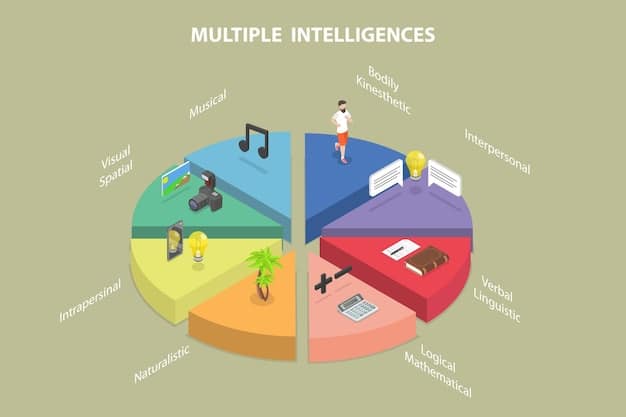US AI Adoption Projected to Grow 18% by 2025: Key Drivers

The projected 18% growth in AI adoption in the US by 2025 is fueled by advancements in AI technology, decreasing costs, and heightened business demand for enhanced efficiency and innovative solutions across various industries.
The United States is poised for a significant surge in artificial intelligence (AI) adoption, with projections indicating an 18% growth rate by 2025. But what’s truly propelling this rapid expansion? This article delves into the key factors **what’s driving the projected 18% growth in US AI adoption by 2025**, identifying the forces that are reshaping the American technological landscape.
The Maturing AI Landscape: Technological Advancements
The foundation of the projected AI adoption growth lies in the rapid advancements in AI technologies themselves. As AI becomes more sophisticated and versatile, it offers a broader range of solutions, making it attractive to businesses across various sectors.
Key Technological Advancements
Several key technological breakthroughs are contributing to the growing appeal of AI. These improvements are making AI more accessible and useful.
- Deep Learning Refinements: Deep learning models are becoming more efficient and accurate, enabling AI to handle more complex tasks with greater precision.
- Natural Language Processing (NLP) Improvements: NLP is enabling machines to better understand and respond to human language, facilitating more natural and effective human-computer interactions.
- Computer Vision Enhancements: Advances in computer vision are allowing AI systems to “see” and interpret images and videos, unlocking new applications in fields like autonomous vehicles and medical imaging.
These technological advancements are not just theoretical; they are translating into real-world applications that are driving significant value for businesses. As AI technologies continue to mature, their usefulness is also growing significantly.

The Role of Data Availability
The exponential growth of data and the increasing availability of large datasets are also crucial factors. AI algorithms thrive on data, and the more data they have access to, the better they perform. This data deluge is enabling AI systems to learn faster and more effectively, leading to more robust and reliable AI solutions.
The combination of these factors is creating a virtuous cycle, where technological advancements and increasing data availability are driving further innovation and adoption of AI. Businesses across the U.S. are recognizing the tremendous potential of AI to transform their operations and are investing heavily in AI initiatives.
In conclusion, the technological advancements in AI, specifically deep learning, NLP, and computer vision, along with the increased data availability, are pivotal in driving the projected growth in AI adoption across the US, creating a landscape ripe for innovation.
Decreasing Costs: Making AI More Accessible
As technology evolves, the costs associated with adopting and implementing AI solutions are decreasing. This cost reduction is opening doors for more small- and medium-sized businesses to take advantage of AI, further fueling its adoption.
The decreasing costs of AI are making it more accessible to a wider range of organizations. Previously, AI adoption was largely confined to large enterprises with significant resources, but now that is changing.
Factors Contributing to Lower Costs
- Cloud Computing: The rise of cloud computing has democratized access to computing power, allowing businesses to leverage AI without investing in expensive hardware infrastructure.
- Open-Source AI Tools: The availability of open-source AI libraries and frameworks is reducing software costs and empowering developers to build AI solutions more quickly and efficiently.
- Increased Competition: As the AI market becomes more competitive, vendors are offering more affordable solutions and pricing models to attract customers.
These elements, combined with an increase in training and AI specialists, are further driving down costs and increasing access for small and medium businesses across various U.S. Markets.
The lower costs are not only attracting more businesses to AI, but they are also enabling organizations to experiment with AI more freely. Businesses are now better able to explore different AI use cases and find the solutions that best fit their needs, without breaking the bank.
Ultimately, lower costs of adoption are the factor opening access to smaller to medium sized business, thus accelerating the adoption and use of AI across the United States.
Growing Business Demand: Efficiency and Innovation
Aside from costs, business demand for AI solutions, driven by heightened need for efficiency and innovative solutions, will be the largest factor in driving AI Adoption.
Enhancing Operational Efficiency
Organizations are increasingly turning to AI to automate tasks, streamline processes, and improve overall efficiency. This is particularly true in industries such as manufacturing, logistics, and customer service, where AI can significantly reduce costs and improve productivity. By automating routine tasks, AI frees up human employees to focus on more strategic and creative activities. This leads to better performance and profit margins.
By optimizing processes and improving decision-making, AI is enabling organizations to unlock new levels of efficiency and agility. This is driving a significant return on investment for AI initiatives and encouraging further adoption.

For example, supply chain optimization is a major application. AI can dynamically monitor and adjust supply chains reducing inefficiencies. In addition, AI is reducing production downtime through predictive maintenance.
Driving Innovation and New Products
In addition to increasing efficiency, AI is also seen as a powerful tool for driving innovation and developing new products and services. By analyzing data and identifying patterns, AI can help organizations uncover new market opportunities and create more personalized customer experiences. This is particularly important in industries such as retail, finance, and healthcare, where customer expectations are constantly evolving.
- Personalized Customer Experiences: AI-powered personalization engines are enabling organizations to deliver more relevant and engaging customer experiences.
- New Product Development: AI is helping organizations develop new products and services more quickly and efficiently.
- Predictive Analytics: AI is being used to predict future trends and market conditions, helping organizations make more informed decisions.
This ability to innovate and stay ahead of the curve is a major driver of AI adoption across industries, leading to innovative solutions not previously conceived of.
Business demand for AI solutions is being driven by the need to enhance operational efficiency and drive innovation. As organizations recognize the potential of AI to transform their operations and create new value, they are investing heavily in AI technologies.
The Role of Government Initiatives and Funding
Government initiatives and funding play an important role in fostering AI adoption in the U.S. By investing in AI research and development and creating a supportive regulatory environment, the government can help accelerate the development and deployment of AI technologies.
Government initiatives and funding are critical for several reasons.
Supporting Research and Development
Government funding supports AI research and development at universities and research institutions. This funding fuels innovation and helps to push the boundaries of what is possible with AI. Government initiatives can also encourage collaboration between academia, industry, and government, creating a vibrant ecosystem for AI innovation.
Additionally, government support helps companies innovate without taking on larger risks.
Creating a Supportive Regulatory Environment
A supportive regulatory environment can encourage AI adoption by providing clarity and certainty for businesses. This includes establishing clear guidelines for data privacy, security, and ethical use of AI. A well-defined regulatory framework can help to build trust in AI and encourage organizations to adopt AI technologies more confidently.
Creating this supportive environmental allows companies to test and implement these technologies with less risk.
Government initiatives and funding are essential for fostering AI adoption in the U.S. By supporting research and development and creating a supportive regulatory environment, the government can help businesses grow and innovate in the ever-changing AI Market.
Addressing Ethical Considerations and Bias in AI
While the growth projections for AI adoption are optimistic, it’s crucial to acknowledge and address the ethical considerations and potential biases inherent in AI systems. These factors can significantly impact public trust and limit the widespread acceptance of AI.
Recognizing and Mitigating Bias
AI algorithms are trained on data, and if that data reflects existing societal biases, the AI system will likely perpetuate those biases. This can lead to unfair or discriminatory outcomes in areas such as hiring, lending, and criminal justice. Identifying and mitigating bias in AI systems is essential to ensure fairness and equity.
- Data Diversity: Ensuring that the data used to train AI systems is representative of the population it will be used on.
- Algorithm Auditing: Regularly auditing AI algorithms to identify and correct biases.
- Transparency and Explainability: Making AI systems more transparent and explainable so that users can understand how they are making decisions.
By taking steps to mitigate these biases, AI and companies can reduce liability and increase their brand equity.
Bias can have huge ethical implications. For example, AI systems used in healthcare could lead to inequitable outcomes for certain demographic groups. In Finance, this can cause groups of people to not be able to be approved for loans.
Ensuring Responsible AI Development
Responsible AI development also involves considering the broader societal implications of AI, such as the potential impact on employment and the need for workforce retraining. By proactively addressing these issues, we can ensure that AI is used in a way that benefits society as a whole.
Ethical Considerations and Bias in AI should not be ignored and should be mitigated. By addressing these critical aspects, we can pave the way for a more equitable and trustworthy AI future.
The Impact of Talent Acquisition and Skill Development
The availability of skilled professionals is a critical factor influencing the pace and extent of AI adoption in the U.S. A well-trained workforce is essential for developing, deploying, and maintaining AI systems effectively.
Addressing the Talent Gap
There is a growing demand for AI specialists, including data scientists, machine learning engineers, and AI researchers. To meet this demand, it is vital to invest in education and training programs that equip individuals with the necessary skills. This does have its challenges.
- University Programs: Expanding AI-related programs at universities and colleges.
- Vocational Training: Providing vocational training opportunities for individuals seeking to enter the AI field.
- Corporate Training: Encouraging companies to invest in internal AI training programs for their employees.
Without developing additional work, there can be a significant lag in adoption of new technologies.
Fostering a Culture of Lifelong Learning
AI is a rapidly evolving field, requiring professionals to continuously update their skills and knowledge. Creating a culture of lifelong learning is essential to ensure that the workforce remains competitive and capable of adapting to new AI technologies. The adoption of new AI capabilities is a rapidly evolving field, thus, those in the AI and STEM field must take special initiative to stay abreast of the latest technological developments.
Ultimately, it will be critical to properly develop and train US employees in order to continue growth in the AI Sector.
| Key Point | Brief Description |
|---|---|
| 🚀 Tech Advancements | Deep learning, NLP, and computer vision propel AI efficiency. |
| 💰 Decreasing Costs | Cloud computing and open-source tools make AI accessible. |
| 📈 Business Demand | AI drives efficiency, innovation, and personalized experiences. |
| 🏛️ Gov Initiatives | Funding R&D and supportive regulations boost AI adoption. |
Frequently Asked Questions
▼
Growth is fueled by breakthroughs in AI tech, lower costs via cloud computing, and surging business demand for efficient and innovative solutions. These aspects collectively make AI appealing and feasible for implementation across various industries.
▼
Decreasing costs, especially due to cloud computing and open-source tools, democratize AI access. Small and medium-sized businesses can now afford to experiment and implement AI solutions, expanding its overall adoption in the US.
▼
Government funding supports AI research, development, and creates a clear, supportive regulatory environment. This encourages innovation, builds trust, and enables organizations to adopt AI technologies confidently, thus furthering its integration.
▼
The primary ethical considerations include mitigating biases in AI systems, and ensuring data represents its population. Algorithm auditing and increasing transparency are also important to promote responsible AI development and fairness.
▼
The availability of skilled professionals such as data scientists and engineers, affects AI adoption. Investing in education and vocational training will help meet the demand and ensure the workforce adapts to new technologies.
Conclusion
As we look towards 2025, the projected 18% growth in AI adoption in the U.S. paints a picture of a technology deeply integrated into the fabric of American business and society. Driven by ongoing technological advancements, decreasing costs, and a surge in business demand, AI is poised to transform industries, enhance efficiency, and drive innovation. While ethical concerns and talent gaps remain challenges, proactive measures to address these issues will pave the way for a future where AI benefits all stakeholders. The continued investment in AI development and deployment will solidify the U.S. as a leader in the global AI landscape.





